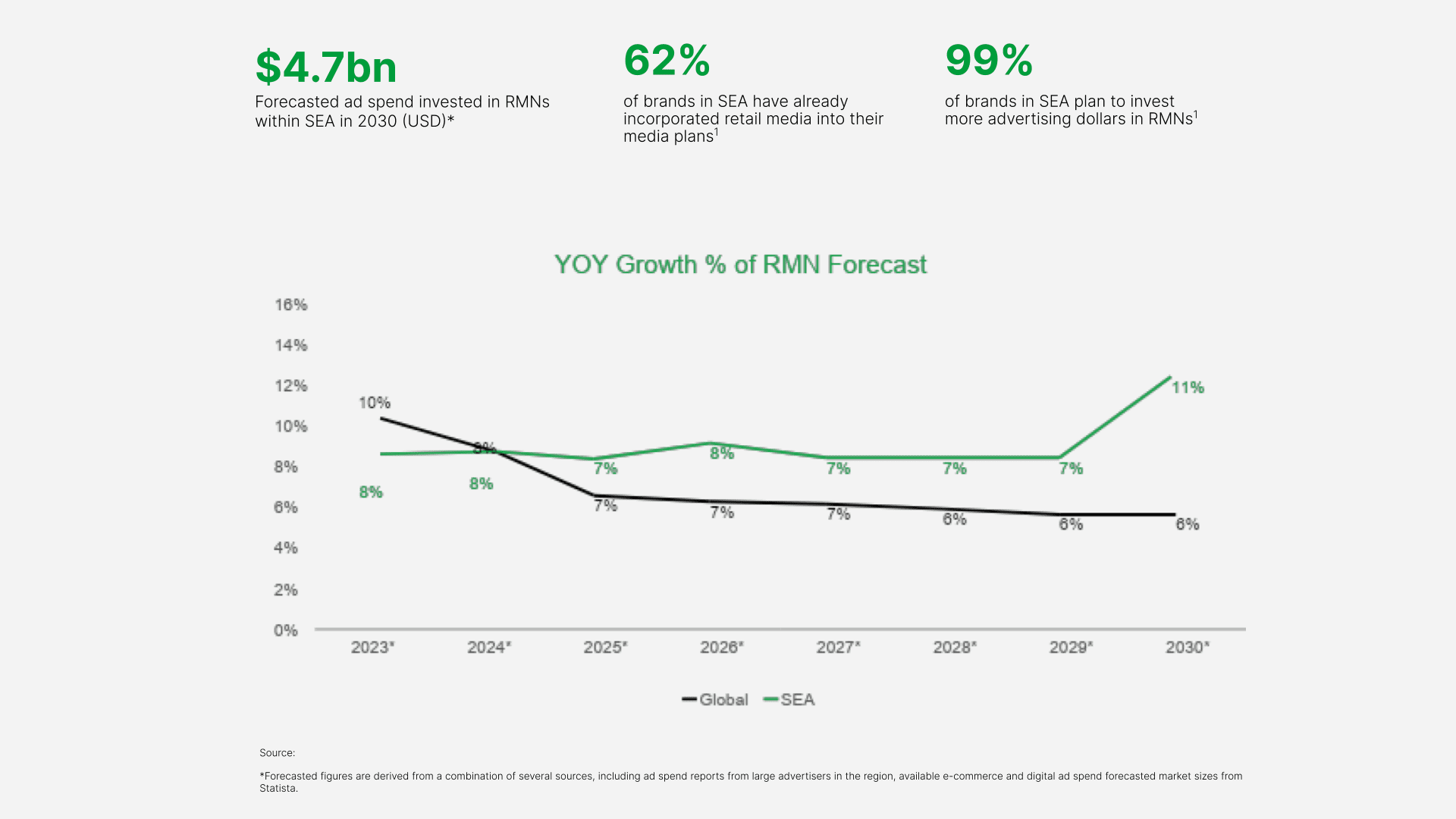Retail Media Networks, the rising advertising superpower
Digital advertising is a rapidly evolving landscape. Throughout my career, I have witnessed multiple times how technological innovations significantly altered our industry. Now, traditional pillars like Search and Social are increasingly giving way to a new wave of innovation—Retail Media Networks (RMNs). While the term ‘retail’ might be somewhat confusing, the truth is you don’t need to be a retailer to have a RMN platform.
This transformative RMN shift is more than a trend. It’s a strategic response to evolving consumer expectations and industry challenges.
RMNs are already redefining the trajectory of digital advertising investments. Global ad spend on RMNs is forecasted to grow at an impressive rate of 73 per cent over the next seven years. Particularly, Southeast Asia ad spend on RMN is forecast to be consistent with or higher than the global RMN spend. In contrast, global ad spend on Social is projected to grow at 45 per cent, and Search at 47 per cent. These were some of the key findings of a recent study conducted by GrabAds and Kantar.

Brands throughout the world, and in Southeast Asia, are presented with a unique opportunity to embrace RMNs and improve the effectiveness of their advertising investments while offering consumers seamless transactions.
First, let’s understand how RMNs differ from other forms of digital advertising.
Ads in the right context, at the right time
Fundamentally, RMNs are digital advertising platforms operated by retailers or service providers. A large e-commerce platform like Amazon or Alibaba can be an RMN. Superapps like Grab, which offer multiple products and services from transportation, food deliveries and financial services can also be RMNs. Both types of platforms offer brands targeted advertising opportunities based on real-time consumer data and purchase behaviours within their retail ecosystem.
That’s different to search or social advertising, where ads are shown to consumers in the context of researching information, or interacting with friends.
Think of it this way: When you come to an e-commerce site or an on-demand platform, you have the intent to search for something you might want to buy. You are likely to complete the purchase on the same platform.
In other digital contexts, you might research something you want to buy, or get inspiration for something you want—but eventually complete the purchase elsewhere. Brands need to employ complex measurement strategies to understand their customer’s journey across various sites and channels. This requires the mining and exchange of customer data by multiple stakeholders. In today’s data privacy-conscious landscape, the limitations of traditional digital advertising channels like Search and Social are becoming increasingly apparent, regardless of whether third party cookies will be phased out.
In contrast, RMNs offer a paradigm shift by leveraging rich first-party data obtained directly from user interactions within the platform ecosystem. This invaluable data allows RMNs to deliver highly targeted and personalised advertising experiences that resonate with audiences at critical moments.
There is something more truly magical at work here. Advertising, which has conventionally been a creative field, is becoming more scientific and data driven. And yet, even creativity in advertising is touching newer heights. Advertisers not only get to have surgical precision to target the right audience, just at the right time, but also be infinitely creative as they engage with consumers throughout their daily lives, from commute, to mealtime, to shopping. Advertisers, and rightly so, are experimenting with ads, across newer formats, that are less intrusive, more personalised, relevant and interactive, and highly contextual.
Measurable Return on Advertising Spend
RMNs offer brands opportunities to reach their customers in the right context, at the right time. But there’s another key advantage over the other forms of digital advertising: the capability to measure the precise impact of an ad campaign.
RMNs give advertisers the superpower to “close the loop,” which is to say they can observe the entire customer journey from viewing the ad, to a potential sales conversion.
If a brand advertises its new product on an e-commerce site or on-demand platform, it sees how many product sales this ad generated, and thus can measure its precise Return on Advertising Spend (ROAS).
This is a massive step up from other forms of advertising. Ads on social networks, alongside search queries, or influencer campaigns, inevitably come with inaccuracies when measuring ROAS, because they occur in different contexts and across different platforms.
This closed-loop attribution, often known as ‘bottom-funnel’, represents a golden and generational shift in the advertising world. But this is not all. RMNs are equally effective in driving awareness and consideration- offering a ‘full funnel’ solution. Infact, a McKinsey survey from a couple of years ago revealed that brands were anticipating allocating close to 1/3rd of their RMN budget towards brand building efforts. One can rightly assume that coming into 2024, this remains as true, if not more, and is a major reason why the popularity of RMNs is rising among advertisers globally as a full funnel opportunity.
The age of superapps
Southeast Asia, our diverse market of nearly 700 million consumers, is truly unique in the way digital behaviours have evolved alongside superapps. GrabAds’ research with Kantar highlighted that 2 out of 3 Southeast Asians surveyed prioritise on-demand access to products and services. This suggests that Southeast Asian consumers prefer seamless, convenient transactions that fulfil their needs promptly. This means that unlike other parts of the world, advertisers in Southeast Asia must also tap into the power of RMNs with superapps.

The Kantar study revealed that RMNs have already gained significant traction among brands in Southeast Asia, with 62 per cent incorporating RMNs into their advertising plans. An overwhelming 99 per cent of brands in Southeast Asia are planning to increase their investments in RMNs. And RMN ad spend in the region is projected to surge to US$4.7 billion by 2030.
The rise of RMNs marks a transformative shift towards precision, relevance, effectiveness, and consumer-centric strategies in digital advertising. And this is why they deserve our immediate attention.
3 Media Close,
Singapore 138498